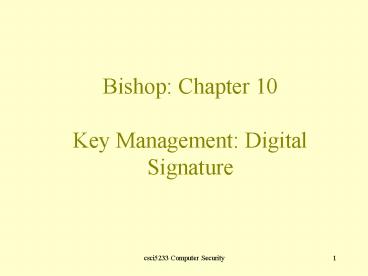Bishop: Chapter 10 Key Management: Digital Signature PowerPoint PPT Presentation
1 / 14
Title: Bishop: Chapter 10 Key Management: Digital Signature
1
Bishop Chapter 10Key Management Digital
Signature
2
Topics
- Key exchange
- Session vs interchange keys
- Classical vs public key methods
- Key generation
- Cryptographic key infrastructure
- Certificates
- Key storage
- Key escrow
- Key revocation
- Digital signatures
3
Digital Signature
- Construct that authenticated origin and contents
of message in a manner provable to a
disinterested third party (judge) - Sender cannot deny having sent message (service
is nonrepudiation) - Limited to technical proofs
- Inability to deny ones cryptographic key was
used to sign - One could claim the cryptographic key was stolen
or compromised - Legal proofs, etc., probably required not dealt
with here
4
Common Error
- Classical Alice, Bob share key k
- Alice sends m m k to Bob
- This is a digital signature. (?)
- WRONG!!
- This is not a digital signature.
- Why? Third party cannot determine whether Alice
or Bob generated the message.
5
Classical Digital Signatures
- Require trusted third party
- Alice, Bob each share keys with trusted party
Cathy - To resolve dispute, judge gets m kAlice, m
kBob, and has Cathy decipher them if messages
matched, contract was signed. - Question Otherwise, who had cheated?
m kAlice
Alice
Bob
m kAlice
Bob
Cathy
m kBob
Cathy
Bob
6
Public Key Digital Signatures
- Alices keys are dAlice, eAlice
- Alice sends Bob
- m m dAlice
- In case of dispute, judge computes
- m dAlice eAlice
- and if it is m, Alice signed message
- Shes the only one who knows dAlice!
7
RSA Digital Signatures
- Use private key to encipher message
- Protocol for use is critical
- Key points
- Never sign random documents, and when signing,
always sign hash and never document - Mathematical properties can be turned against
signer - Sign message first, then encipher
- Changing public keys causes forgery
8
Attack 1
- Example Alice, Bob communicating
- nA 95, eA 59, dA 11
- nB 77, eB 53, dB 17
- 26 contracts, numbered 00 to 25
- Alice has Bob sign 05 and 17
- c mdB mod nB 0517 mod 77 3
- c mdB mod nB 1717 mod 77 19
- Alice computes 05?17 mod 77 08 corresponding
signature is 03?19 mod 77 57 claims Bob signed
08 - Judge computes ceB mod nB 5753 mod 77 08
- Signature validated Bob is toast
9
Attack 2 Bobs Revenge
- Bob, Alice agree to sign contract 06
- Alice enciphers, then signs
- (meB mod 77)dA mod nA (0653 mod 77)11 mod 95
63 - Bob now changes his public key
- Computes r such that 13r mod 77 6 say, r 59
- Computes r eB mod ?(nB) 59?53 mod 60 7
- Replace public key eB with 7, private key dB 43
- Bob claims contract was 13. Judge computes
- (6359 mod 95)43 mod 77 13
- Verified now Alice is toast
10
El Gamal Digital Signature
- Relies on discrete log problem
- Choose p prime, g, d lt p compute y gd mod p
- Public key (y, g, p) private key d
- To sign contract m
- Choose k relatively prime to p1, and not yet
used (Note 0 lt k lt p-1) - Compute a gk mod p
- Find b such that m (da kb) mod p1
- Signature is (a, b)
- To validate, check that
- yaab mod p gm mod p
11
Example
- Alice chooses p 29, g 3, d 6
- y 36 mod 29 4
- Alice wants to send Bob signed contract 23
- Chooses k 5 (relatively prime to 28 and 0ltklt28)
- This gives a gk mod p 35 mod 29 11
- Then solving 23 (6?11 5b) mod 28 gives b 25
- Alice sends message 23 and signature (11, 25)
- Bob verifies signature gm mod p 323 mod 29 8
and yaab mod p 4111125 mod 29 8 - They match, so Alice signed
12
Attack
- Eve learns k, corresponding message m, and
signature (a, b) - Extended Euclidean Algorithm gives d, the private
key - Example from above Eve learned Alice signed last
message with k 5 - m (da kb) mod p1 (11d 5?25) mod 28
- so Alices private key is d 6
13
Key Points of Ch. 10 (Bishop)
- Key management critical to effective use of
cryptosystems - Different levels of keys (session vs.
interchange) - Keys need infrastructure to identify holders,
allow revoking - Digital certificates
- Key escrowing complicates infrastructure
- Digital signatures provide integrity of origin
and content - Much easier with public key cryptosystems than
with classical cryptosystems
14
Next
- Bishop, Chapter 11
- Cipher techniques

